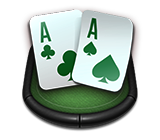
Since the 19th century, poker has been a strategic game enjoyed in casinos and gambling halls. Today, it has claimed international fame and attracts players worldwide to participate in tournaments.
These participants share more than the goal of winning grand money. They all have the same question, “How to win a poker game?”
Well, let us tell you, with the right moves up your sleeve, you can dominate and win a poker game. In this blog, we have combined several tricks and tips that will help you win. So, without further delay, let’s get started!
Tricks for Winning a Game of Poker
If you want to win the game, you must know how, whom, and when to play. The following tricks are well-tested. When played right, they can significantly raise your chances of winning.
Play a Limited, Aggressive Hands
Even the top players of No Limit Texas Hold'em can afford to play a stipulated number of starting hands.
Developing a solid preflop strategy is the easiest way to improve your results and win a poker game. Downloading free preflop charts can help you create strong ranges, but sticking to them is tough. Hold your patience and play steady with calculated hands.
The most effective strategy is to play a limited selection of strong hands aggressively. However, it's also important to occasionally play weaker hands aggressively. This balanced approach masks the true strength of your hand, making it difficult for opponents to accurately read your play. As a result, you become a more challenging and unpredictable opponent at the table.
Avoid Being The First Player To Limp
Limping is a move where a poker player calls the big blind before the flop rather than folding or raising. There are two main reasons to avoid this move. They are:
Limping doesn't allow you to win the pot preflop like a raise does.
You offer the following players tempting pot odds, increasing the likelihood of facing multiple opponents and decreasing your chances of winning.
Limping can only be justified when at least another player has limped before you. This move is called over-limping, and it can be a strategic play since the pot odds act in your favor to join the hand. In this case, you have a good chance of hitting something good on the flop.
Use Your Bluffing Skills while Drawing Hands
You need to know how to bluff effectively to be a top player and win a poker game. However, there is a substantial risk of bluffing relentlessly: you can quickly lose all your money at the table. So, how can you master the bluffing frequency?
The best way to bluff is to consider both your cards and the situation at the table. It means bluffing with hands that have the potential to improve to the best hand in the long run, like flush draws, straight draws, or even just an overcard or two to the board.
Think of these draws as your backup plan if your bluff gets called. Poker players often call this move “semi-bluff” for its capability to go beyond bluff.
Play Your Strong Hands Aggressively to Build the Pot and Encash
It is sad to see a player check their flopped nut flush three times and then show their strong hand when the opponent checks the river. Players who avoid chasing their opponents out of the pot often make the mistake of playing slow hands.
The simple answer to "How to win a poker game?" is to increase the pot and protect your equity. That does not mean you should always bet or raise your strong hands post-flop.
You can check your strong hands if:
Your hand is unlikely to be outdrawn.
You don't have enough cards to scare your opponent away.
Your opponent's range is primarily composed of hands without showdown value.
To avoid confusion, bet (or check-raise if you weren't the preflop aggressor). It is frustrating to see your opponent fold, but it's better than being outdrawn or losing on potential money.
Tips on How To Win in a Poker Game
Now that we are thoroughly familiar with the advanced tricks, let’s discuss some basic tips on how to win a poker game.
Attack at the Sign of Your Opponent’s Weakness
Players often don't check with hands that can withstand multiple bets, which generally indicates a weaker hand when they do check. When faced with several bets, these hands are more likely to fold. This is the same as the bluffing situation mentioned earlier.
When you spot your opponent's weakness in a heads-up pot, you should utilize the scope and play a strong bluff. Combine your usual semi-bluffs with a pure bluff with a few empty hands, ideally with good blocker effects.
Know When to Fold
Despite your best efforts, you might get defeated. The quality of a professional poker player is knowing when to lay down a good hand. Although it sounds simple, it’s hard to practice. Naturally, one is curious to know and eager to win.
In the case of folding, a player has to let go of the chance to win the pot and satisfy their curiosity by finding out their opponent’s hand. However, this is crucial for improving your game. If you are confused about whether to call or fold versus a bet or raise, folding is your best bet.
Choose your Game Wisely
To win at poker, play against weaker players. While some may argue this is against the sportsman spirit, that is how the game rolls.
It is crucial to position yourself in a situation where you have the best chance to win. You must let go of your ego and play against weaker players to excel at poker.
Here is a simple rule of thumb: you need to be better than half the players in the game to secure a positive win rate.
Closing Ideas
With these tricks and tips on how to win a poker game, you can dominate tables, build a strong profile, and wind grand cash prices. Try these out and let us know which one helped you the most.

















